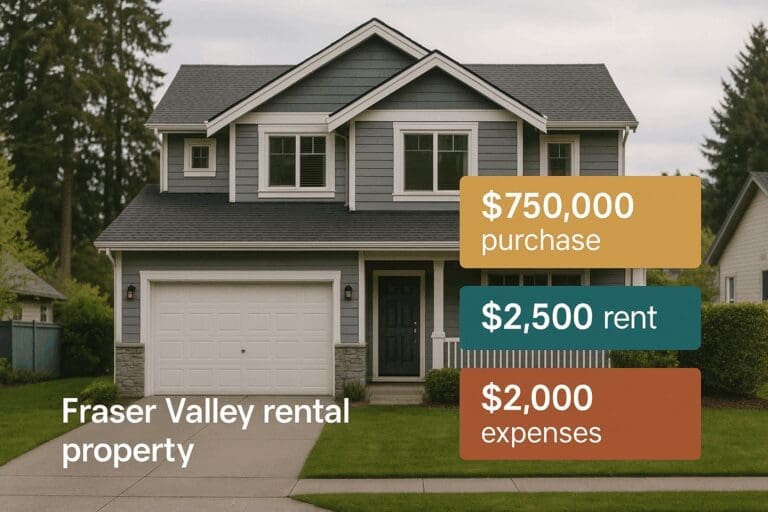
For many Fraser Valley homeowners, years of rising home values have quietly built up a valuable resource: home equity. Tapping into this equity to purchase a rental property can be a smart way to expand wealth, diversify income, and take advantage of local real estate opportunities without selling your primary residence.
Real estate investors and first-time landlords in areas such as Abbotsford, Chilliwack, Mission, and Langley are increasingly utilizing equity-based strategies to enter the rental market. With the proper financial guidance and mortgage structure, this approach can help turn your home’s equity into a springboard for long-term financial growth.
Home equity is the difference between your home’s current market value and the remaining balance on your mortgage. For example, if your home is worth $800,000 and you owe $400,000, you’ve built $400,000 in equity. In British Columbia, where property appreciation has been substantial over the past decade, many homeowners have significant equity that can be accessed without selling their home.
You can access this equity in several ways. Refinancing your mortgage allows you to replace your existing mortgage with a larger one, receiving the difference as a lump sum. A home equity line of credit (HELOC) works similarly to a credit card, with a set borrowing limit and interest-only payments, providing flexibility for phased expenses. A third option is taking a second mortgage, which involves securing an additional loan against your property without affecting your existing mortgage. Each approach offers varying degrees of access, repayment flexibility, and interest rates, and should be selected based on your financial goals and risk profile.
Using equity from your primary residence allows you to finance a down payment—or in some cases, the majority of the cost—of a rental property without tapping into savings or selling other investments. This accelerates your entry into the rental market while helping preserve personal liquidity.
The interest rates on mortgages or secured credit are typically lower than those on unsecured loans, making the cost of borrowing more manageable. If you’re using borrowed funds specifically to generate rental income, the interest may also be tax-deductible. You continue to own your primary residence while unlocking its value to build wealth elsewhere. In doing so, you gain leverage, allowing a relatively modest amount of equity to fund a much larger real estate investment. This approach aligns well with long-term financial strategies focused on portfolio diversification and income generation, particularly for individuals planning for semi-retirement or early financial independence.
Buying a rental property comes with different lending conditions than buying your own home. In Canada, lenders require a minimum 20% down payment for non-owner-occupied properties, and this cannot be insured by CMHC. The approval process also involves stricter debt servicing ratios, especially if the purchase includes multiple units.
Lenders want reassurance that the rental income can reasonably support the mortgage, which means you’ll need to provide either current lease agreements or a market rent appraisal. Additionally, some investment mortgages may carry higher interest rates or insurance premiums due to the increased risk. Your personal credit score, debt levels, and income all play a role in how much you can borrow, even when the rental will generate income. These stricter criteria make proper preparation critical before starting your mortgage application.
Homeowners looking to use their equity to invest in rental properties often choose between a HELOC or a cash-out refinance. Both are effective, but they suit different financial strategies.
A HELOC provides a revolving credit facility, usually up to 65% to 80% of your home’s appraised value, minus any existing mortgage. This option is attractive for its flexibility: you borrow only what you need, when you need it, and often make interest-only payments. It works particularly well if you’re planning staged expenses, such as renovations or staggered property purchases. However, the variable interest rate means your payments can rise if rates increase.
Key benefits of a HELOC:
Refinancing, on the other hand, replaces your current mortgage with a new, larger one, providing the difference in cash. This method is often more suitable for those ready to make a property purchase immediately. It offers a predictable repayment structure with fixed or variable options, which can simplify your financial picture by consolidating your debt under a single mortgage. For example, a homeowner in Abbotsford with a $900,000 home and a $350,000 mortgage might refinance to access up to $370,000–$400,000 in usable funds, depending on their income and the lender’s criteria.
Equity-based investing can increase risk if not approached cautiously. Overborrowing or underestimating expenses may strain your finances—build in a buffer to protect against market shifts.
While using home equity to finance a rental property can be an effective strategy, it’s not without risk.
Potential challenges to consider:
Many new landlords also underestimate the time and legal obligations involved in property management. Budgeting for professional management or thoroughly understanding the Residential Tenancy Act in British Columbia will save you stress and potential legal trouble. Having a well-structured financial plan and consulting with a mortgage professional can help mitigate these risks.
Important Reminder:
Always leave room for unforeseen expenses, rate changes, or future needs. Conservative planning reduces long-term risk.
Rather than relying on individual anecdotes, it’s more effective to look at the financial mechanics that shape the success of using home equity for rental investment. For example, a homeowner with $300,000 in accessible equity might consider using $180,000 as a down payment on a $750,000 rental property. With a 20% down payment requirement, this leaves room for closing costs, initial repairs, or a small contingency buffer.
Assuming a rental income of $2,500 per month and monthly expenses—including mortgage payments, taxes, insurance, and maintenance—totalling around $2,000, this setup could yield a modest positive cash flow. But outcomes will vary widely depending on location, property type, tenant turnover, and borrowing terms. Running multiple scenarios using different vacancy rates, interest rate assumptions, and maintenance costs is a valuable exercise before making any commitments.
This type of analysis provides a clearer picture of whether the opportunity aligns with your financial comfort zone and long-term objectives.

Many rental investors aim for a debt-service coverage ratio (DSCR) of 1.2 to 1.4 to maintain healthy margins. This means your rental income should exceed expenses by at least 20–40%.
Before using home equity for a rental purchase, it’s essential to project your rental cash flow with accuracy. This means considering not only mortgage payments but also less predictable costs.
Common operating expenses include:
Vacancy periods must also be factored into your calculations. Many experienced landlords use an estimated vacancy rate of 5% to 8% annually when forecasting income. It’s equally important to build a reserve fund for unexpected repairs or emergency maintenance, such as appliance replacement, roof leaks, or plumbing issues. Taking a conservative approach in your budgeting ensures that you can weather both normal fluctuations and unexpected costs without financial strain.
Analyzing your cash flow realistically will help determine if the investment aligns with your goals. This exercise also gives lenders greater confidence in your preparedness as a borrower, which in turn strengthens your mortgage application.
Helpful Tip:
Many investors aim for a debt-service coverage ratio (DSCR) of 1.2 to 1.4. This ensures your rental income exceeds all related expenses by 20–40%, building in a healthy financial buffer.
Not every homeowner is suited to equity-based investing. Those who benefit most typically have at least 35% to 40% equity in their current home, along with stable income and strong credit. A long-term perspective on real estate, combined with a willingness to either manage a property or work with a professional property manager, is essential.
It’s also important to have clearly defined goals. Are you looking to generate monthly income, build long-term wealth, or both? Your answers will determine how aggressively to borrow and what type of rental property suits your plan.
Using the equity in your Fraser Valley home to invest in rental property can be a practical financial strategy when done with care and thoughtful preparation. Understanding your borrowing power, weighing the risks, and building a plan that aligns with your lifestyle and financial capacity are all critical steps.
The rental market continues to evolve, and with strong demand in communities across the Fraser Valley, those positioned with stable equity and a clear investment outlook can take meaningful steps toward property-based income generation.
Most lenders require that you maintain at least 20% equity in your primary home after borrowing. To invest comfortably, aim for 35–40% total equity before using it.
Not typically. Most lenders require a traditional mortgage on the rental itself. The HELOC is usually used for the down payment, while the remainder is financed through a rental mortgage.
Yes, interest paid on funds borrowed to generate income—such as rent—is generally tax-deductible. Always confirm details with a licensed tax professional.
Real estate is a long-term investment. Maintaining conservative borrowing ratios and positive cash flow can help protect against market dips.
Yes, but qualification depends on your total debt load, income, and credit score. Rental income can often help offset the new mortgage requirements.